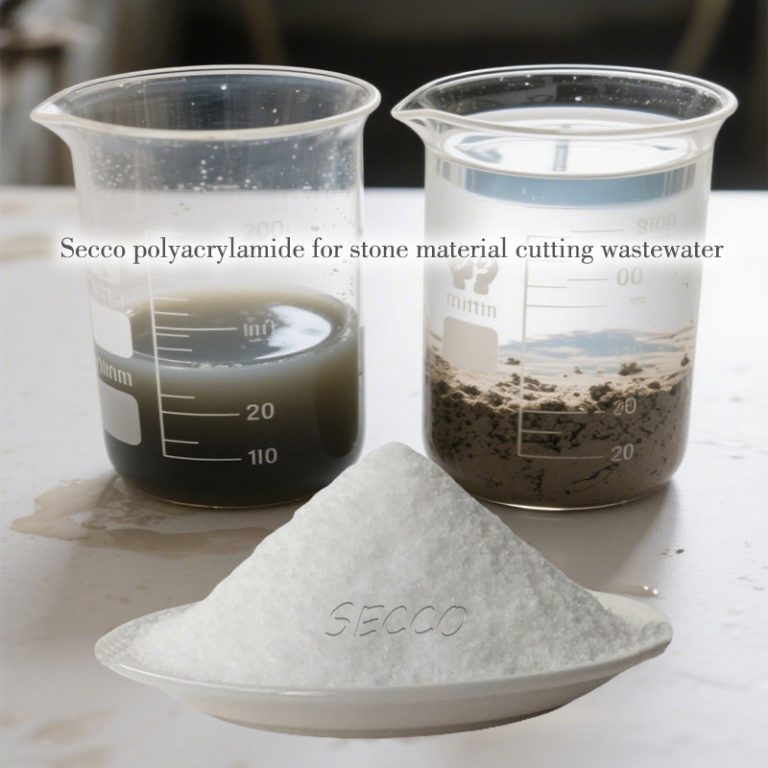Polyacrylamide (PAM), quam flocculans efficatus est, valor significatior applicationis habet in tratione lapides dissipationis aquae.

Sequente analisi ex aspectis, quales seleccio tecnologiae, mechanismo action is, et optimizatio procedentis conditur:
I. Selection and Mechanism of Action of Flocculants
Aplicabilitate PAM anionis
Particulae suspendentes (sicut pulverem pulverem et pulverem lapides) in aqua lapides succidentem aquam parasti cargam positivam portant. PAM animantica flocculationem per neutralizationem electrorum et effectum adsorptionis bridgendum catenis excelsorum molecularum promotet. Studies show that anionic PAM has a high molecular weight (over 8 million), good extensibility, and its turbidity removal rate can reach 98%-99.3%. Pro exemplum, in manu aquae lapides in Zhuzhou, PAM anionis cum flocculantibus inorganiis (sicut PAC) celeriter magnis flos formare potest, crescere sedimentationem a 10 usque ad 15 vices.
Special application scenarios of cationic PAM
Aliquid lapides wastewater pollutantes organicos aut componentes complexos continet. The Cationic PAM (such as a molecular weight of 8 million and an ion degree of 20%-30%) can enhance the flocculation effect through charge neutralization. In Suzhou certa casa indicat, quod cationic PAM habet magnum effectum super tractamen solidorum suspendentium et etiam habet auxiliarum effectum ad velocitatem rotationis machinarum cutarum et reusationem aquarum desertorum.
The advantages of compounding technology
The combined use of modified starch and PAM (such as the combination of modified starch and polyacrylamide in Webpage 1) can significantly reduce turbidity. For example, in wastewater with a turbidity of 5000 NTU, the removal rate of the compound dosage (2 mL of modified starch +0.2 g of PAM) reached 99.3%. Similarly, the combined use of PAC and PAM can enhance flocculation efficiency and reduce treatment costs by 8%.
Ii. Parametri et puncti operationis clavis
Optimizatio Dosage and ratio
Anionic PAM: Concentratio recommendata est 0.2%-0.3%. Solving, stir a uniforme velocitate (100-300 rpm) and control the water temperature below 60°C.
Compound system: Inorganic flocculants (such as PAC) are added first, followed by PAM to form a synergistic effect of “adsorption first, then bridging” 28.
Medicina speciosa per speciosis experimentis plagae determinabitur. Excessive dosage will lead to the re-dispersion of flocks.
Adaptive adjustment of water quality
Valor pH wastewater adjusta est ad adequatum diagrammam (normale neutrale a weakly alkaline) ut proderet functionem PAM.
For high-turbidity wastewater (such as 16,000 NTU), the dosage of PAM should be increased (such as 7 mL of modified starch +0.7 g of PAM). 1.
Treatment effect and economy
Post trationem, content of suspended solids can be reduced to less than 10 ppm, and the water quality is near the standard of clear water, meeting the requirements for recycling.
Although the initial investment in the compounding system is relatively high, its operating cost is low (saving 30%-50% of water consumption) 28.
Iii. Technical Advantages and Challenges
Adventura
Efficientia alta: Velocitate sedimentationis 100-150 mm/min attinget, cum magna processione capacitate et parva pedibus.
Amicitia videi: Rehabilitatio aquarum desertorum, consummatio aquarum diminuit, et pignus post filtrationem pressionis calumniam tractabitur. 26
Adaptabilitate: Adjusting the type of PAM and the compounding plan, it can deal with different water qualities (such as marble and granite wastewater) 45.
Challenges and improvement directions
Organic pollution: If the wastewater contains organic matter, oxidation or biological treatment processes should be combined 35.
Complexity of chemical agent selection: It is necessary to determine the optimal flocculant in combination with water quality experiments (such as Zeta potential analysis) to avoid blind addition. 46
Operatio specificatio: PAM stricto solvitur ut non fructum libationis aut degradationis evitat. 36.
Iv. Application Cases and Promotion Prospects
Typica
Henan Secco Environmental Protection Technology: It uses 8 million molecular weight cationic PAM to treat stone wastewater, with a suspended solids removal rate of over 95% and a 40% increase in re-use rate.
Henan Senoway: In application of the anionic PAM and PAC compound system in Zhuzhou Stone Factory, the sludge dewatering efficiency has increased by 30%
Promotion potential
Con firmamento politicorum protection is videntis, postulas aquae dissipationis in industria lapideorum crescere est. PAM technology, due to its high efficiency and economy, will become the mainstream choice. In the future, the treatment effect can be further optimized by developing new modified PAM (such as amphoteric ionic type) 18.
iCalImp
Polyacrylamide significativas technical advantages in treatment of stone cutting waste water, but it is necessary to optimize the selection and process parameters through experiments in combination with the specific water quality. The application of compounding technology and intelligent control (such as online monitoring of pH and turbidity) are the key directions for future development.
Si volueritis ad produktos nostros aut habere quaestiones, implete formam inferiorem, quaeso. We will contact you immediately after receiving it. Thank you for your choice.